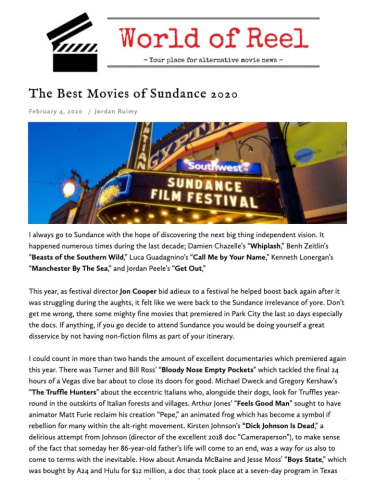The Best Movies of Sundance 2020
World of Reel
02/04/2020
Back
By Jordan Ruimy
I always go to Sundance with the hope of discovering the next big thing independent vision. It happened numerous times during the last decade; Damien Chazelle’s “Whiplash,” Benh Zeitlin’s “Beasts of the Southern Wild,” Luca Guadagnino’s “Call Me by Your Name,” Kenneth Lonergan’s “Manchester By The Sea,” and Jordan Peele’s “Get Out,”
This year, as festival director Jon Cooper bid adieux to a festival he helped boost back again after it was struggling during the aughts, it felt like we were back to the Sundance irrelevance of yore. Don’t get me wrong, there some mighty fine movies that premiered in Park City the last 10 days especially the docs. If anything, if you go decide to attend Sundance you would be doing yourself a great disservice by not having non-fiction films as part of your itinerary.
I could count in more than two hands the amount of excellent documentaries which premiered again this year. There was Turner and Bill Ross’ “Bloody Nose Empty Pockets” which tackled the final 24 hours of a Vegas dive bar about to close its doors for good. Michael Dweck and Gregory Kershaw’s “The Truffle Hunters” about the eccentric Italians who, alongside their dogs, look for Truffles year-round in the outskirts of Italian forests and villages. Arthur Jones’ “Feels Good Man” sought to have animator Matt Furie reclaim his creation “Pepe,” an animated frog which has become a symbol if rebellion for many within the alt-right movement. Kirsten Johnson’s “Dick Johnson Is Dead,” a delirious attempt from Johnson (director of the excellent 2018 doc “Cameraperson”), to make sense of the fact that someday her 86-year-old father’s life will come to an end, was a way for us also to come to terms with the inevitable. How about Amanda McBaine and Jesse Moss’ “Boys State,” which was bought by A24 and Hulu for $12 million, a doc that took place at a seven-day program in Texas where more than 500 male teenagers form their own fake two-party government, run campaigns and hold elections — encouraging civil discourse was the key here, partisanship the last option, as the ultimate question asked by these kids was should I stick to my beliefs or have them compromised just for the sake of winning? Want more? other notable docs included Garret Bradley’s “Time,” David France’s “Welcome to Chechnya,” Bryan Fogel’s “The Dissident,” Malte Aberdi’s “The Mole Agent,” and Benjamin Ree’s “The Painter and the Thief.”
Much like last year, when Lulu Wang’s “The Farewell” seemed to be the only wowser to screen in the U.S. dramatic competition, this 2020 edition failed to deliver many U.S. dramatic game-changers.
There were shades of brilliance in Lee Isaac Chung’s exquisitely rendered immigration saga “Minari,” which was the first movie since 2016 to win both the U.S. dramatic Audience and Jury Prize. An A24 distributed film, set for a summer release, derived from Chung’s own experiences as a 7-year-old boy, had a Korean family struggling to make ends meet in rural Arkansas. Also winning both the Audience and Jury award, but this time in the NEXT section, Heidi Ewing’s touching and tender “I Carry You With Me” was a mix docu-fiction filmmaking of the highest order, a brilliant hybrid dealing with a 20-year-romance between two Mexican men who decide to, dangerously, cross the border and start a new life in New York City. Carey Mulligan delivered the performance of her career in “Promising Young Woman,” a kind of feminist “Death Wish” which had its director Emerald Fennell, an immaculate new visual stylist, showing absolutely no mercy towards men who crossed the line and preyed on vulnerable women. Andy Samberg also gave us career-best work in Max Barbakow’s “Palm Springs,” an uproariously inventive rom-com that used the Groundhog Day time loop gimmick, but turned it over its head with heartfelt drama and comedy, you’ll be hard-pressed to find a better comedy this year. Then there was Robert Machoian’s astonishing minimalist triumph “The Killing of Two Lovers,” a NEXT section selection, a taut, tense and terrific noir about infidelity and rage. After triumphing at Sundance, back in 2011, with “Martha Marcy May Marlene,” director Sean Durkin came back with his sophomore effort “The Nest” which felt like the work of a director in full command of his frames – much like ‘Martha,’ the film was composed of mostly medium and wide shots, always keeping the viewer at a distance, but thrillingly on the edge of their seats. Eliza Hittman made good on the promise of her excellent 2018 films “Beach Rats” by delivering the thoroughly gripping “Never Rarely Sometimes Always,” the best movie I saw at Sundance 2020. This abortion drama had a 17-year-old girl who finds out she’s 18 weeks pregnant, but cannot get an abortion in conservative-minded small-town Pennsylvania, and decides to travel to New York City to get the procedure done. There, alongside her teenage cousin, she goes through the frustratingly elaborate and complicated system of getting an abortion. Hittman’s film, which will compete at the Berlin Film Festival this month, is highly influenced by euro-cinema but brings a fresh new vision to the game. It might be a small indie but, much like the best movies that have come out of Sundance over its close to 40 years of existence, it packs a wallop.
12 days, 49 movies.
My Top 10 films from Sundance 2020
1) Never Rarely Sometimes Always
2) The Truffle Hunters
3) The Killing of Two Lovers
4) Bloody Nose Empty Pockets
5) Promising Young Woman
6) Palm Springs
7) I Carry You With Me
8) The Nest
9) Minari
10) Possessor